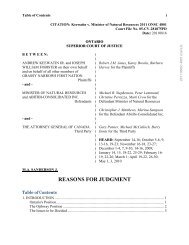Omers Energy Inc. v. Alberta (Energy Resources Conservation Board)
Omers Energy Inc. v. Alberta (Energy Resources Conservation Board)
Omers Energy Inc. v. Alberta (Energy Resources Conservation Board)
- No tags were found...
You also want an ePaper? Increase the reach of your titles
YUMPU automatically turns print PDFs into web optimized ePapers that Google loves.
Page: 18production extends the primary term of a lease, the parties would have anticipated production atsomething more than trivial or minuscule production. Certainly they would not have anticipated thata lessee could hold a lease by shutting in a well that was not capable of producing a meaningfulamount, even if not every moment would have been in paying quantities. In my view, although the<strong>Board</strong> was not prepared to read the words “in paying quantities” into the contract, it adopted therationale underlying the American cases and was proper in doing so.3. Did the <strong>Board</strong> chose the correct test?[78] What then is the proper interpretation of Clause 3 of the Cymbaluk Lease and did the <strong>Board</strong>err in its interpretation of “capable of producing the leased substances”? An interpretation whichdefeats the purpose of the parties in entering an agreement should be discarded in favour of aninterpretation which promotes that purpose and a sensible commercial result: Bearspaw PetroleumLtd v Encana Corporation, 2011 ABCA 7, 39 Alta LR (5th) 302; Mannai Investment Co Ltd v EagleStar Life Assurance Co Ltd, [1997] 3 All ER 352 (HL), cited in Nickel Developments Ltd v CanadaSafeway Ltd, 2001 MBCA 79, 156 Man R (2d) 170 at para 34.[79] The <strong>Board</strong> conducted a cogent analysis of the Suspended Wells Clause within the contextof the entire lease, and in particular in relation to the Habendum Clause. It found that the SuspendedWells Clause mirrors the Habendum Clause, and that for the Suspended Wells Clause to apply toextend the lease, there must be either a shut-in well on the lands that is capable of producing, or ifthe well is not capable of production, operations, as defined in 1(g), must commence with nocessation of more than 90 consecutive days between successive operations. As well, the <strong>Board</strong> notedthat to extend the lease under the Habendum and Suspended Wells Clauses the lessee mustundertake operations if a producing well is no longer producing the leased substances or if asuspended or shut-in well is no longer capable of producing the leased substances (<strong>Board</strong> Decision8).[80] When dealing with the interpretation of “capable of producing the leased substances”, the<strong>Board</strong> correctly found two factors must be satisfied. First, the well had to be capable of producingand, second, it had to be capable of producing the resource in a meaningful quantity. The <strong>Board</strong>found that to satisfy the “capable” requirement, the well must have the ability to produce in itsexisting configuration and state of completion. Applying that concept to the present case, the <strong>Board</strong>rejected <strong>Omers</strong>’ argument that because well head pressures showed the existence of gas in thewellbore, the well was capable of producing the leased substance and all that was needed was aroutine water clean out operation. The <strong>Board</strong> correctly found that a well could not be capable ofproducing the leased substances and at the same time in need of an operation to address the waterloading to do so. Rather, the lease calls upon the lessee to address the water loading situation if itis required to produce the leased substances in meaningful amounts. With respect to the 100/05-4Well, the <strong>Board</strong> looked at the history of the well and concluded that it was not capable of producingthe leased substances and at the same time be in need of an operation to address the water loadingsituation to do so.
















